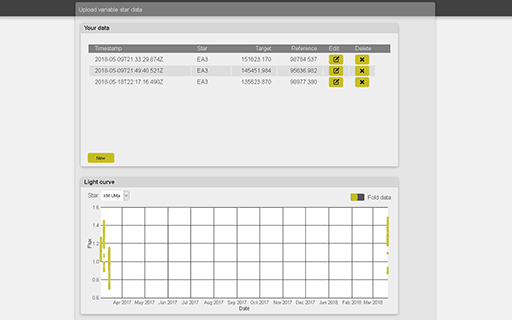3.1 View your results on the light curve
This short video and the following activity explain how to review the light curve with your results.

Transcript
After watching the video, submit your own results to be added to the light curve by following the steps in Activity 3.
Activity _unit9.4.1 Activity 3 Reviewing the light curve
Open the light curve plotting tool
- Go to the Astronomy with an online telescope COAST webpage [Tip: hold Ctrl and click a link to open it in a new tab. (Hide tip)] :
and select the link Variable star light curve. This takes you to the light curve plots for all of the variable stars being investigated at different times of the year by participants on this course.
Check your data
- In the upper half of the variable star plotter is a box labelled Your data. The results that you added in Activity 2 should be listed there. Check that the date and time and name of the variable star are correct.
- If necessary you can edit the values, change the name of the variable star or delete any data point using the Edit and Delete controls on the right hand side.
View the plot
- To view the light curve, select your star from the dropdown list in the Light Curve pane in the lower half of the display.
- Your data points will be shown in red, together with data points contributed by other participants which are shown in green.
- By default each observation is plotted in date order, meaning that observations made over a period of time may be spread out over many orbits of the binary star. To make the pattern of the curve easier to see, select Fold data by moving the slider at the top right of the light curve graph to the right. This combines data points from different orbits so that the graph represents a single orbit of the binary pair.
